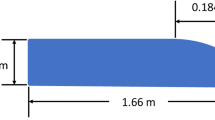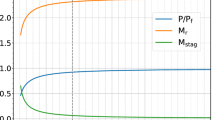Abstract
Simulations of a complete reflected shock tunnel facility have been performed with the aim of providing a better understanding of the flow through these facilities. In particular, the analysis is focused on the premature contamination of the test flow with the driver gas. The axisymmetric simulations model the full geometry of the shock tunnel and incorporate an iris-based model of the primary diaphragm rupture mechanics, an ideal secondary diaphragm and account for turbulence in the shock tube boundary layer with the Baldwin-Lomax eddy viscosity model. Two operating conditions were examined: one resulting in an over-tailored mode of operation and the other resulting in approximately tailored operation. The accuracy of the simulations is assessed through comparison with experimental measurements of static pressure, pitot pressure and stagnation temperature. It is shown that the widely-accepted driver gas contamination mechanism in which driver gas ‘jets’ along the walls through action of the bifurcated foot of the reflected shock, does not directly transport the driver gas to the nozzle at these conditions. Instead, driver gas laden vortices are generated by the bifurcated reflected shock. These vortices prevent jetting of the driver gas along the walls and convect driver gas away from the shock tube wall and downstream into the nozzle. Additional vorticity generated by the interaction of the reflected shock and the contact surface enhances the process in the over-tailored case. However, the basic mechanism appears to operate in a similar way for both the over-tailored and the approximately tailored conditions.
Similar content being viewed by others
References
Stalker, R.J., Crane, K.C.A.: Driver gas contamination in ahigh-enthalpy reflected shock tunnel. AIAA J. 16277–278 (1978)
Skinner, K.A.: Mass spectrometry in shock tunnel experiments of hypersonic combustion. PhD thesis, The University of Queensland, Brisbane, Queensland, Australia (1994)
Paull, A.: A simple shock tunnel driver gas detector. Shock Waves6(5), 309–312 (1996)
Mark, H.: The interaction of a reflected shock wave with theboundary layer in a shock tube. J. Aeronaut. Sci. 304–306April (1957)
Burtschell, Y., Cardoso, M., Zeitoun, D.E.:Numerical analysis of reducing driver gas contamination in impulseshock tunnels. AIAA J. 39(12), 2357–2365 (2001)
Cardoso, M., Burtschell, Y., Zeitoun, D., Abgrall, R.: Numerical simulation of different methods for avoidingdriver gas contamination in shock tunnels. In: Proceedings of the 21st International Symposium on ShockWaves, vol. 1, pp. 537–542. Panther Publishing, Great Keppel, Australia (1997)
Sharma, S.P., Wilson, G.J.: Test times in hypersonic shock tubes.In: 33rd AIAA Aerospace Sciences Meeting and Exhibit, AIAA Paper95-0713, Reno, Nevada (1995)
Wilson, G.J.: Numerical studies of high-enthalpy impulsefacilities. In: Proceedings of the 20th International Symposium onShock Waves, vol. 1. World Scientific Publishing Co. Pty. Ltd., California Institute of Technology, Pasadena, California (1995)
Chue, R.S.M., Eitelberg, G.: Studies of the transient flows inhigh enthalpy shock tunnels. Exp. Fluids 25 474–486(1998)
Badcock, K.J.: A numerical simulation of boundary layer effects ina shock tube. Int. J. Num. Methods Fluids 14 1151–1171(1992)
Austin, J.M., Jacobs, P.A., Kong, M.C., Barker, P., Littleton, B.N., Gammie, R.: The small shock tunnel facility at UQ.Department of Mechanical Engineering Report 2/1997, The Universityof Queensland, Brisbane July (1997)
Craddock, C.S., Jacobs, P.A., Gammie, R.: Operational instructionsfor the small shock tunnel at UQ. Department of MechanicalEngineering Report 8/1998, The Universityof Queensland, Brisbane July (1998)
Jacobs, P.A.: MB_CNS: A computer program for the simulationof transient compressible flows. Department of MechanicalEngineering Report 10/1996, The University of Queensland, BrisbaneOctober (1996)
Wada Y., Liou, M.S.: A flux splitting scheme with high-resolutionand robustness for discontinuities. In: 32nd AIAA AerospaceSciences Meeting, AIAA Paper 94-0083, Reno, NV (1994)
Macrossan, M.N.: The equilibrium flux method for the calculationof flows with non-equilibrium chemical reactions. J. Comput.Phys. 80(1), 204–231 (1989)
Goozée, R.J.: Simulation of a complete shock tunnel withparallel computer codes. PhD thesis, The University of Queensland, Brisbane, Queensland, Australia (2003)
Gordon, S., McBride, B.J.: Computer program for calculation ofcomplex chemical equilibrium compositions and applications; I.Analysis. Reference Publication 1311, NASA October (1994)
McBride, B.J., Gordon, S.: Computer program for calculation ofcomplex chemical equilibrium compositions and applications; II.Users manual and program description. Reference Publication1311, NASA June (1996)
Rothkopf, E.M., Low, W.: Diaphragm opening process in shock tubes.Phys. Fluids 17(6), 1169–1173 (1974)
Baldwin, B.S., Lomax H.: Thin layer approximation and algebraicmodel for separated turbulent flows. In: 16th AIAA AerospaceSciences Meeting, AIAA Paper 78-257, Huntsville, Alabama (1978)
Buttsworth, D.R., Jacobs, P.A.: Total temperature measurements in ashock tunnel facility. In: Thompson, M.C., Hourigan, K. (eds.) 13thAustralasian Fluid Mechanics Conference, Melbourne, pp. 51–54December (1998)
Weber, Y.S., Oran, E.S., Boris, J.P., Anderson, J.D., Jr.: Thenumerical simulation of shock bifurcation near the end wall of a shock tube. Phys. Fluids 7 2475–2488 (1995)
Cambier, J.L., Tokarcik, S., Prabhu, D.K.: Numerical simulationsof unsteady flow in a hypersonic shock tunnel facility. In: 17th AIAA Aerospace Ground Testing Conference, pp. 127–140, Nashville, TN July (1992)
Petrie-Repar, P.J.: Numerical simulation of diaphragm rupture. PhDthesis, The University of Queensland, Brisbane, Queensland, Australia (2000)
Sudani, N., Valiferdowsi, B., Hornung, H.G.: Test time increase bydelaying driver gas contamination for reflected shock tunnels.AIAA J. 38(9), 1497–1503 (2000)
Chue, R.S.M., Itoh, K.: Numerical analysis of reflectedshock/boundary layer interaction in a high enthalpy shock tunnel.In: Proceedings of the 20th International Symposium on ShockWaves. World Scientific Publishing, California Institute ofTechnology, Pasadena, California (1995)
Author information
Authors and Affiliations
Corresponding author
Additional information
Communicated by R. R. Boyce
Rights and permissions
About this article
Cite this article
Goozée, R.J., Jacobs, P.A. & Buttsworth, D.R. Simulation of a complete reflected shock tunnel showing a vortex mechanism for flow contamination. Shock Waves 15, 165–176 (2006). https://doi.org/10.1007/s00193-006-0015-4
Received:
Accepted:
Published:
Issue Date:
DOI: https://doi.org/10.1007/s00193-006-0015-4




